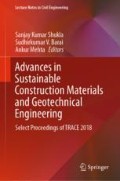Abstract
In the present study, mix design ingredients viz. water, cement, ground granulated blast-furnace slag (GGBS), aggregate (fine and coarse), ground blast-furnace slag (GBS) and chemical admixture were collected, tested and the findings are presented in this paper for Joda and Khondbond Iron Mines Expansion Project, Orrisa for Tata Steel Limited. Tata Steel Group is implementing ground granulated BF slag (GGBS + GBS) in its entire construction project sites after preparing a proper mix design. Compatibility (complex interaction between cement [1,2,3] and chemical admixtures [4]) may be issued because of the large variation of fine contents during the trials. Due to incompatibility between cement and chemical admixtures, concrete may face various problems during the concreting works viz. late setting of concrete, fast slump loss/moisture loss, inadequate strength increase, cracking, etc. These problems may affect the properties of fresh and hardened concrete viz. primary strength and durability. Compatibility between GGBS blended cement and chemical superplasticizer (IS: 9103) was confirmed by Marsh cone test. Considering the compressive strength of cement mortar, setting time of concrete, workability, compressive strength and durability (measured in terms of rapid chloride penetration test (RCPT)) and the mix design for M30 grade of concrete were prepared with 40% replacement of cement by GGBS and 25% replacement of sand by GBS. During the course of trials/study, the main objective was to find the effect of fines (GGBS + GBS) content on the properties of concrete. Many research papers have been published pertaining to GGBS utilization/properties but GGBS + GBS concrete is rarely seen after recent advancement in IS 383 pertaining to the uses of aggregate from unconventional sources.
Access this chapter
Tax calculation will be finalised at checkout
Purchases are for personal use only
References
IS 269:33 Grade Ordinary Portland cement—specification
IS 8112: 43 Grade ordinary Portland cement—specification
IS 12269:53 Grade ordinary Portland cement—specification
IS 9103: Concrete admixtures—specification
Latha KS, Rao MVS, Reddy SV (2012) Estimation of GGBS and HVFA strength efficiencies in concrete with age. Int J Eng Adv Technol (IJEAT), 2(2), ISSN: 2249–8958, Dec 2012
Li C, Yoda A, Yokomur T (1998) Pore structure, strength and carbonation of cement pastes containing ground granulated blast-furnace slag. Fly Ash, Silica Fume, Slag and Natural Pozzolana in Concrete, SP 178, American Concrete Institute, Farmington Hills, Mich., pp 875–892
Arivalagan S (2014) Sustainable studies on concrete with GGBS as a replacement material in cement. Jordan J Civil Eng 8(3):2014
Pavia S, Condren E (2008) Study of the durability of OPC versus GGBS concrete on exposure to silage effluent. ASCE J Mater Civil Eng 20(4), Apr 2008
IS 4032: Method of chemical analysis of hydraulic cement
IS 383: Coarse and fine aggregates for concrete
IS 2386: Methods of test for aggregates for concrete
IS 456: Plain and reinforced concrete—code of practice
IS 4634: Batch type concrete mixers—method of test—performance
IS 4925: Concrete batching and mixing plant—specification
IS 10262: Recommended guidelines for concrete mix design
IS 455: Portland slag cement—specification
IS 12089: Specification for granulated slag for the manufacture of Portland slag cement
ACI Committee 233 report, slag cement in concrete and mortar ACI 233R-03 American Concrete Institute, Farmington Hills, March 2003
Duos C, Eggers J (1999) Evaluation of ground granulated blast furnace slag in concrete (Grade 120). Rpt. No. FHWA/LA-99/336, Louisiana Trans. Res. Center, Baton Rouge, Louisiana, Oct 1999, 45 p
Bijen J (1996) Blast furnace slag cement for durable marine structures. Stichting Beton Prisma, Netherlands
Malhotra VM (1987) Properties of fresh and hardened concrete incorporating ground granulated blast furnace slag. In: Malhotra VM (ed) Supplementary cementing materials for concrete. Canadian Government Publishing Centre, Ottawa, pp 291–331
Acknowledgements
The author would like to thank Shri. S. L. Gupta, Director, CSMRS, Dr. R. Chitra, Group Head (Soil and RSD), CSMRS and Dr. N. P. Honkanadavar, Division Head (RF and SD) for their continuous support in carrying out the above study. Thanks are also to the staff of rockfill division, CSMRS for their help during the testing.
Author information
Authors and Affiliations
Corresponding author
Editor information
Editors and Affiliations
Rights and permissions
Copyright information
© 2020 Springer Nature Singapore Pte Ltd.
About this paper
Cite this paper
Chakraborty, U.B., Bajaj, S., Dhanote, S. (2020). Experimental Investigation to Study the Properties of Concrete Incorporated with GGBS and GBS. In: Shukla, S., Barai, S., Mehta, A. (eds) Advances in Sustainable Construction Materials and Geotechnical Engineering. Lecture Notes in Civil Engineering , vol 35. Springer, Singapore. https://doi.org/10.1007/978-981-13-7480-7_24
Download citation
DOI: https://doi.org/10.1007/978-981-13-7480-7_24
Published:
Publisher Name: Springer, Singapore
Print ISBN: 978-981-13-7479-1
Online ISBN: 978-981-13-7480-7
eBook Packages: EngineeringEngineering (R0)

